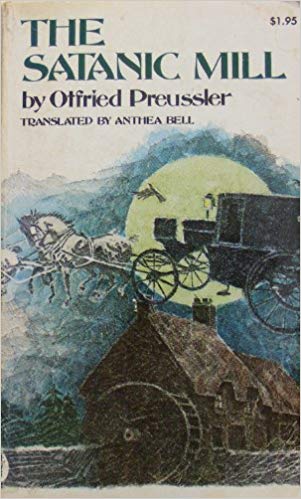 By OTFRIED PREUSSLER (Collier Books; 1971/72)
By OTFRIED PREUSSLER (Collier Books; 1971/72)
This German children’s novel predated the HARRY POTTER books by over 25 years, and the similarities are undeniable. THE SATANIC MILL is about Krabat, a fourteen year old homeless boy who takes what he thinks is an apprentice position to the master of the titular mill. In fact, Krabat has joined a satanic school in which he and eleven other young men are instructed in the art and practice of black magic, a field in which the Master happens to be an expert. The HARRY POTTER similarities end there, as THE SATANIC MILL is ultimately a much darker and, I think, more resonant work.
Set down in highly poised, erudite prose, it’s a deeply strange novel in its quintessentially European approach to the supernatural, which is treated in an oddly disaffected, matter-of-fact manner. Transformations of humans into various animals are commonplace occurrences, as are spells and telekinesis.
The narrative is highly episodic and picturesque in nature, giving us a day-by-day account of Krabat’s interactions with the Master and his fellow pupils. Also included are a lot of enjoyable vignettes, such as a brief sojourn outside the school in which a pupil is transformed into an ox in order to scam a moneyed dealer, and another in which the boys are called upon to play nonexistent instruments for a military parade that sound “as if the entire Royal Swedish Military Band were marching along the road.” Dreams play a large part in the story, serving as both premonitions and oblique commentaries on what is happening at any given moment.
Inevitably Krabat comes to hate life in the mill, especially since at the end of the every year one of his fellow pupils dies suspiciously. Krabat longs to escape, but is unable due to the magic hold the Master exerts over his charges. He may, however, find a chance for an exit in the form of a young woman singer with whom Krabat grows besotted—falling in love, you see, lessens the Master’s hold, and can even do him serious damage.
It all adds up to pleasing diversion, and certainly an above-average example of kid lit. The author combines an unusually fecund imagination with a strong eye for realism, and does so in consistently readable fashion. I just wish the book’s arc were a bit less predictable, as the darkness-defeated-by-the-power-of-love angle is, as I’m sure you’re probably aware, something of a cliché.
